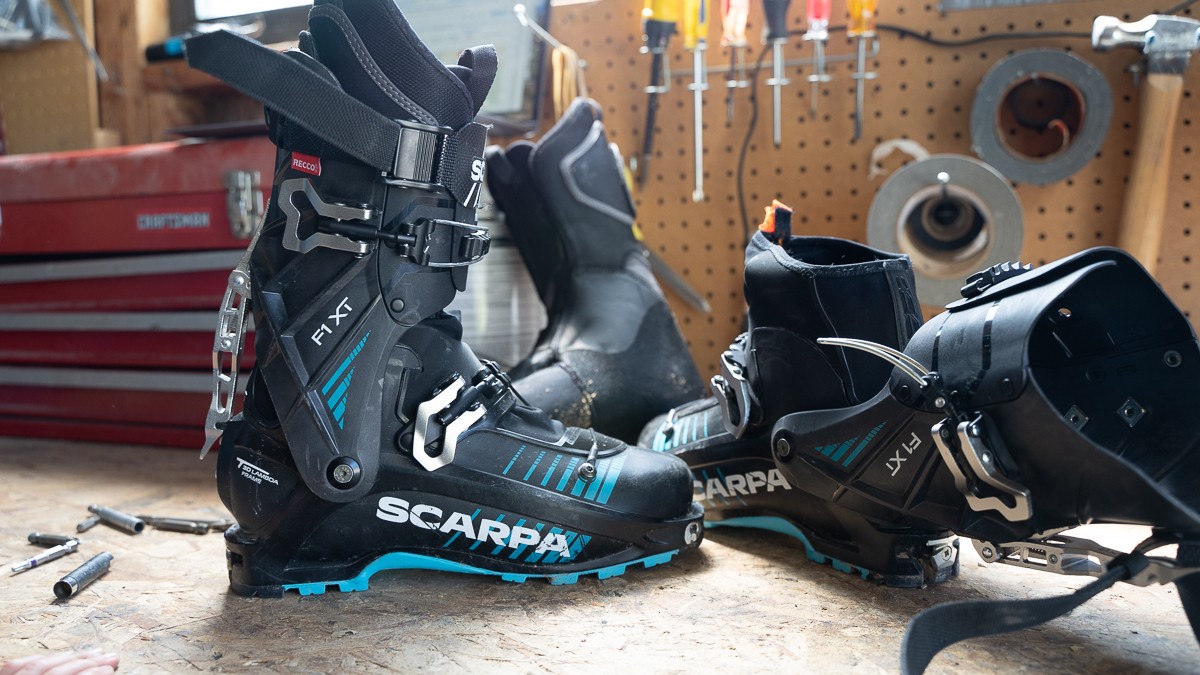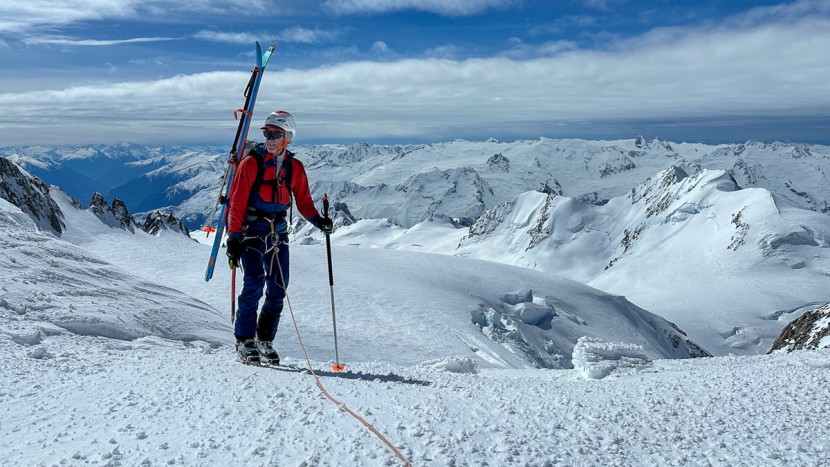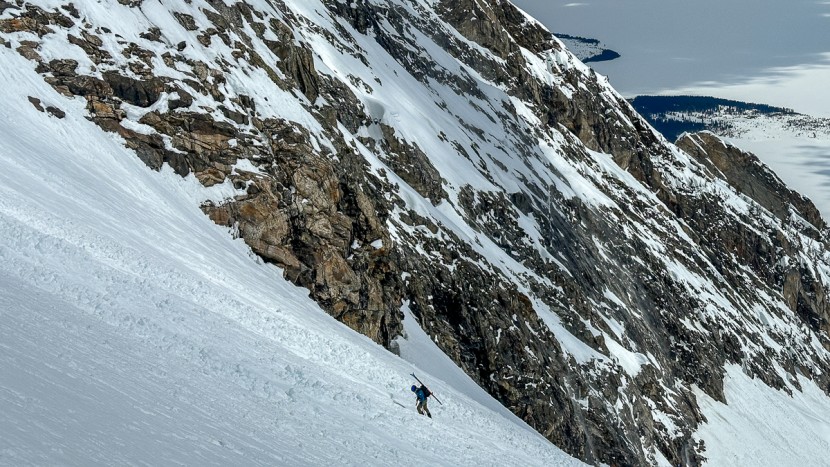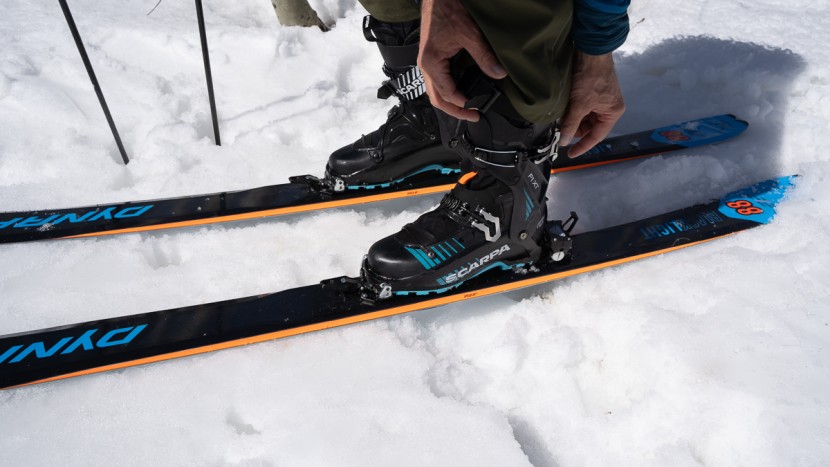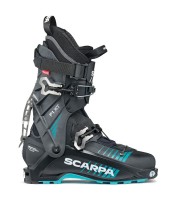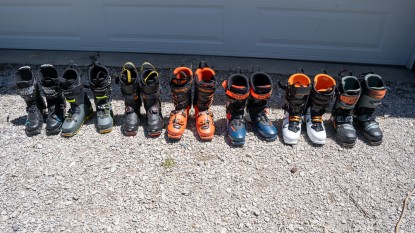
Our Verdict
Our Analysis and Test Results
A Note on Sizing
The F1 family of Scarpa boots are low profile and tend to run small. It's also important to note that Scarpa “splits” their shell sizes; for example, mondo sizes 26.5 and 27 are the same shell size. Our lead tester has worn and tested size 27.0 F1 boots regularly since 2005. However, with this round, we noticed that their performance fit was a bit tighter than F1 boots of the past. Make sure you take a look at Scarpa's particular sizing chart to line up the best fit for your foot.
Downhill Performance
With backcountry ski gear, all design criteria are conflicting, but especially so when it comes to boots. Bless the manufacturers that keep stretching the ways backcountry ski gear is able to perform. We admit that it's hard to avoid the statement, “This is good, for the weight,” when writing these reviews. In the case of the F1 XT, it needs to be restated, especially considering their touring efficiency. These aren't the most powerful downhill boots in our review. However, no other boot in this weight class will surpass their downhill performance.
The F1 XT offers a dynamic flex pattern that is light years ahead of the “brick wall” feeling that previously defined lightweight touring boots. It also features more than enough lateral stiffness to support skiing in any condition. The forward flex pattern is immediately soft before ramping up nicely to provide ample stiffness, but it still isn't as evenly graduated as the beefier boots we tested. Centered, balanced skiing won't push the limits of this boot, but clumsy or responsive “survival skiing” will – with enough force, you can fold the F1 XT over, eventually.
Uphill Performance
To improve the F1 XT's touring and climbing efficiency, you would have to sacrifice considerable downhill performance. These are excellent, efficient touring boots that save you enough energy on the uphill that you can savor your descent. We measured the range of motion of the cuff of the F1 Xt at 108 degrees, which is an absurd amount of flexion. Unless you are a gymnast, your ankle will likely not flex that far forward or backward. We don't know what you would do in the mountains to require that range of motion, but it certainly helps this boot walk well.
Even more important than the range of motion – once that range of motion exceeds 45 degrees or so – is the resistance within the range of motion. A number of variables contribute to this resistance: rivet friction, the interplay between shell parts, the interplay between shell and liner, and liner stiffness. Of course, it also depends on how you buckle your boots in touring mode, which will vary from user to user. The cuff resistance on the F1 XT is remarkably low, especially relative to its close competition.
Weight
One complete F1 XT (liner and shell, minus insole or footbed) weighs 1076 grams, which works out to 4 pounds 12 ounces for a pair. You would need to add at least 100 grams to each boot before you find a pair that skis as well or better than the F1 XT. And to find a pair of boots that are meaningfully lighter, you would have to sacrifice a substantial amount of downhill skiing ability. Again, the F1 XT strikes an excellent balance for its weight.
Out of the total weight of 1076 grams per boot, 872 grams of that are in the shell, while 204 grams are in the liner. The stock liner in the F1 XT is made by Intuition, which is a nice enhancement. With these boots, you are less likely to seek an aftermarket liner as an “upgrade,” as the stock liner is made by the same company that makes most aftermarket liners.
Comfort and Fit
In qualitative terms, the fit of the F1 XT is slightly narrow in the forefoot and relatively wider around the heel, with predictably average volume around the instep and arch of your foot. Folks with wider or higher-volume feet will likely need to do some work in the toe box; others with particularly narrow heels or ankles may need to fill some space there. However, any extra effort will result in nicely fitting, high-performance boots.
The liner is thin and stiff, which is good for performance but could negatively affect your first impressions of fit. If you compare these boots to ones with a wider last and cushier liner, these won't feel nearly as comfortable. Ski both of those boots over a few weeks, however, and the F1 XT will perform more closely to its original form while you will be swimming in the wider and cushier boot as you curl your toes looking for purchase and support. For our part, we'll take long-term performance over the initial feel any day.
Warmth
As we just discussed, the liner on the F1 XT is relatively thin. We know folks who have successfully fitted their boots with thicker liners to improve warmth, but this usually requires sizing up. If you fit these for well-balanced performance, they won't be as warm as beefier boots. In some ways, this is the biggest difference between this boot and the average ski-touring boot. The additional shell material in heavier boots offers greater insulation but also adds 100-200 grams to each boot.
Most skiers seeking a high-speed touring boot won't care much about warmth. They intend to keep the blood flowing and plan to be home before their toes even have time to get cold. Expedition skiers, however, who need to balance efficient climbing against the hours of kicking around camp in their boots will have to think closely about their choices.
Ease of Use
Just two generations ago – which, in boot time, is only a few years – the predecessor to the F1 XT was able to transition from touring to ski mode with just one move. However, fashion design has changed, and very few boots now feature a one-move transition. The F1 XT requires three moves to change modes from downhill to uphill and vice versa. Much about ski boot design has pushed forward, but in our opinion, ease of use has not.
Thanks to the huge range of motion in the shell cuff range of motion, you can move the boot shell upper portion entirely out of the way to get your foot in and out of the boot. That said, there is a stretchy gaiter that squeezes the liner and slightly impedes your entry and exit, but generally, this was a non-issue.
Should you Buy the Scarpa F1 XT?
If you have read this far, you likely understand the limitations of a boot in this weight class – for our part, you hopefully now understand why the F1 XT is the best in its class. For the weight and touring performance, you can't get a boot with better downhill ski performance. The converse is true, too. The F1 XT is a well-balanced, high-performance ski boot that allows you to ascend at a high pace and descend with confidence.
What Other Backcountry Ski Boots Should You Consider?
If you're focused on boots that weigh less than 1100 grams per boot, you should also consider boots like the Tecnica Zero G Peak Carbon, Dynafit TLT X, and Salomon S/Lab MTN Summit. The Tecnica Zero G doesn't ski as well as the Scarpa F1 XT, but it is a touch lighter. Despite the stated last, the Salomon MTN fits a bit wider than the relatively narrow F1 XT. It is marginally heavier, but it skis a bit better. The Dynafit TLT X is notable for its smooth, one-move transition.
| Awards | Best Lightweight Backcountry Ski Boot |
|---|---|
| Price | $900 List Check Price at Backcountry |
Overall Score  |
|
| Star Rating | |
| Bottom Line | This is widely considered to be the best "speed touring" boot on the market |
| Pros | Lightweight, huge range of motion touring mode, solid performance (for the weight) |
| Cons | Incongruous fit with narrow toe box and wide heel cup, no "one move" transitions |
| Rating Categories | Scarpa F1 XT |
| Downhill Performance (35%) | |
| Uphill Performance (20%) | |
| Weight (20%) | |
| Comfort and Fit (10%) | |
| Warmth (10%) | |
| Ease of Use (5%) | |
| Specifications | Scarpa F1 XT |
| Weight per Pair (Size 26.5) | 4 lbs 12 oz |
| Binding Compatibility? | Tech only |
| Measured Range of Motion (degrees) | 108° |
| Manufacturer Stated Last Width | 100 mm |
| Weight of One Complete Boot, No Insole | 1076 g |
| Weight of One Boot Shell | 872 g |
| Weight of One Stock Liner, No Footbed | 204 g |
| Stated Flex Index | Not Listed |
| Liner Design | Tongue |
| Shell Material | Grilamid |


